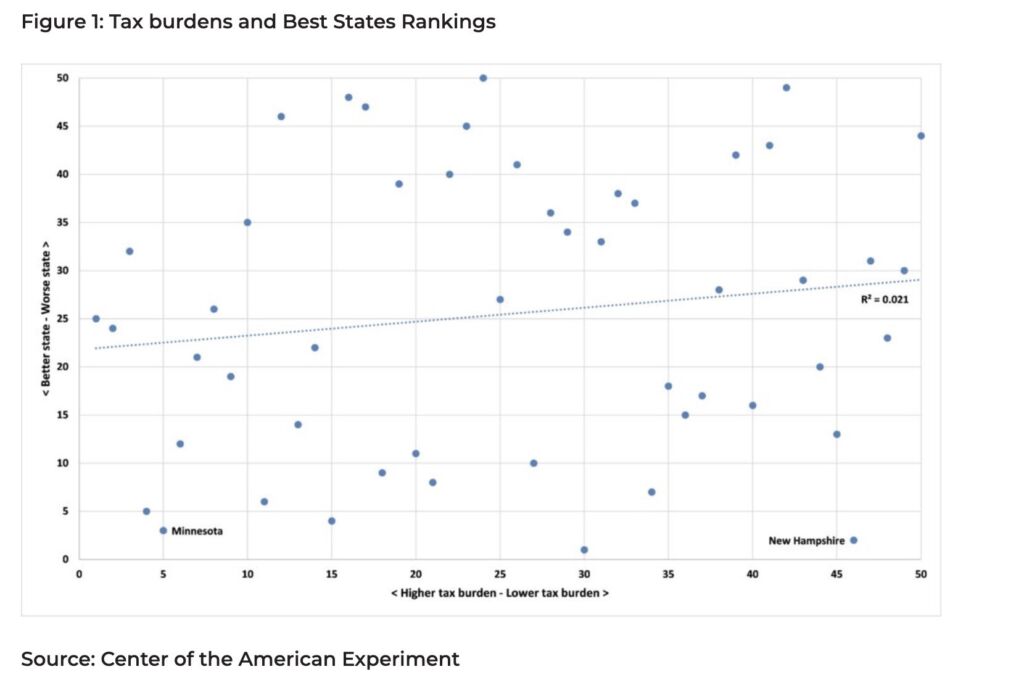Higher taxes will not give Minnesotans a better quality of life
Minnesotans, on average, pay a higher price for their government compared to residents of other states. A lot of high-tax advocates claim that this makes it possible for Minnesota to offer a higher quality of life to its residents compared to other low-tax states.
Taxes in Minnesota are some of the highest in the country. And despite a $17.5 billion surplus, they are about to go up. Reason? Our legislators, Governor Walz specifically, want to make Minnesota Minnesota the best state in the country, especially for children and families.
But to the extent that Minnesota offers a high quality of life for its residents, is that directly due to the high taxes that we pay?
Quality of life in Minnesota
Certainly, compared to most states, Minnesota does offer a higher quality of life. As Tom Horner summarized in a recent MinnPost opinion article,
The state’s population is well-educated, enjoys world-class natural and cultural amenities, is safer than most places in the country (even with a recent spike, the rate of violent crime rate in Minnesota is 30% lower than the national average), has a median household income well above the national average (and a poverty rate that ranks among the lowest of all states) and residents of Minnesota are among the healthiest people in the nation.
On rankings that look at the quality of life, like US News, Minnesota also tends to rank favorably. This year, for example, Minnesota ranked as the fifth-best state in the country to live. And in a 2020 study published by the Federal Reserve, Minnesota had the country’s highest level of welfare (or living standard).
To a lot of people, this tends to give the impression that our high taxes, consequently high government spending, are largely responsible for such results. Thereby, if we must maintain our quality of life, or better yet, raise it, we must keep taxes high or raise them.
Or as one successful entrepreneur recently put it in an interview
If you want to belong to a high-end country club, you have to expect to pay the dues
The idea that high taxes support a high quality of life is, however, unsupported by the data. Moreover, a lot of the issues that politicians are trying to solve exist despite our high levels of taxation and spending. It’s highly unlikely that after decades of high taxes and high spending, more taxes and more spending will suddenly do the trick.
No relationship between quality of life and taxes
As I did write in a previous blog, despite ranking as the fifth-best state in the country, Minnesota ranks poorly on some of the more important indicators that have a significant influence on people’s well-being. These include things like education, the economy, healthcare, and crime. So, to some extent, the US News study itself is a problematic measure of the quality of life.
Nevertheless, leaving aside any issues associated with the ranking, Minnesota’s ranking does not appear to be driven by high taxes. In his 2021 report, for example, where he found that Minnesotans are leaving the state for low-tax states, my colleague John Phelan tested the link between taxation and quality of life. Using rankings from the US News Best State rankings, he found that high taxes bear no relationship to quality of life (as measured by the US News).

In fact, even looking at the most recent US News ranking, the four states that rank higher than Minnesota in quality of life rank significantly lower on tax burden than Minnesota (using the most recent analysis of state-local tax burden from the state foundation). And out of the top ten states with the best quality of life, only Vermont ranks higher than Minnesota on tax burden.
Certainly, to the extent that a high-tax state uses its revenues to invest in high-quality public goods or services, such as education or healthcare, such taxes can appear to drive the quality of life (especially for vulnerable groups). But tax revenues are not necessarily tied to tax rates. Tax revenues are, however, associated with the size of the economy. A growing economy, even with low tax rates allows the state government to get high revenues which can be used for various government services.
Currently, Minnesota already spends highly on government services compared to other states. Minnesota’s spending is also at historic highs. Yet despite such high levels of spending, we still contend with the existing socio-economic woes that our politicians are aiming to solve. The idea that more money will solve everything does not stand scrutiny.